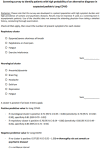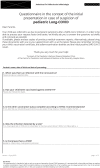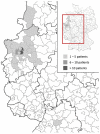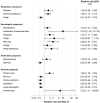High Prevalence of Alternative Diagnoses in Children and Adolescents with Suspected Long COVID-A Single Center Cohort Study
- PMID: 36851793
- PMCID: PMC9961131
- DOI: 10.3390/v15020579
High Prevalence of Alternative Diagnoses in Children and Adolescents with Suspected Long COVID-A Single Center Cohort Study
Abstract
Background: Long COVID (LC) is a diagnosis that requires exclusion of alternative somatic and mental diseases. The aim of this study was to examine the prevalence of differential diagnoses in suspected pediatric LC patients and assess whether adult LC symptom clusters are applicable to pediatric patients.
Materials and methods: Pediatric presentations at the Pediatric Infectious Diseases Department of the University Hospital Essen (Germany) were assessed retrospectively. The correlation of initial symptoms and final diagnoses (LC versus other diseases or unclarified) was assessed. The sensitivity, specificity, negative and positive predictive values of adult LC symptom clusters were calculated.
Results: Of 110 patients, 32 (29%) suffered from LC, 52 (47%) were diagnosed with alternative somatic/mental diseases, and 26 (23%) remained unclarified. Combined neurological and respiratory clusters displayed a sensitivity of 0.97 (95% CI 0.91-1.00) and a negative predictive value of 0.97 (0.92-1.00) for LC.
Discussion/conclusions: The prevalence of alternative somatic and mental diseases in pediatric patients with suspected LC is high. The range of underlying diseases is wide, including chronic and potentially life-threatening conditions. Neurological and respiratory symptom clusters may help to identify patients that are unlikely to be suffering from LC.
Keywords: differential diagnoses; pediatric Long COVID; post COVID; post-acute sequelae SARS-CoV-2 infection; symptom cluster.
Conflict of interest statement
The authors declare no conflict of interest.
Figures








References
-
- Swann O.V., Holden K.A., Turtle L., Pollock L., Fairfield C.J., Drake T.M., Seth S., Egan C., Hardwick H.E., Halpin S., et al. Clinical characteristics of children and young people admitted to hospital with COVID-19 in United Kingdom: Prospective multicentre observational cohort study. BMJ. 2020;370:m3249. doi: 10.1136/bmj.m3249. - DOI - PMC - PubMed
-
- Rao S., Lee G.M., Razzaghi H., Lorman V., Mejias A., Pajor N.M., Thacker D., Webb R., Dickinson K., Bailey L.C., et al. Clinical Features and Burden of Postacute Sequelae of SARS-CoV-2 Infection in Children and Adolescents. JAMA Pediatr. 2022;176:1000–1009. doi: 10.1001/jamapediatrics.2022.2800. - DOI - PMC - PubMed
-
- Soriano J.B., Murthy S., Marshall J.C., Relan P., Diaz J.V., WHO Clinical Case Definition Working Group on Post-COVID-19 Condition A clinical case definition of post-COVID-19 condition by a Delphi consensus. Lancet Infect. Dis. 2022;22:e102–e107. doi: 10.1016/S1473-3099(21)00703-9. - DOI - PMC - PubMed
-
- Vilser D. Long Covid/Post-COVID-19-Syndrom bei Kindern und Jugendlichen. Pädiatrie. 2022;34:20–25. doi: 10.1007/s15014-022-4024-2. - DOI
MeSH terms
LinkOut - more resources
Full Text Sources
Medical
Miscellaneous

